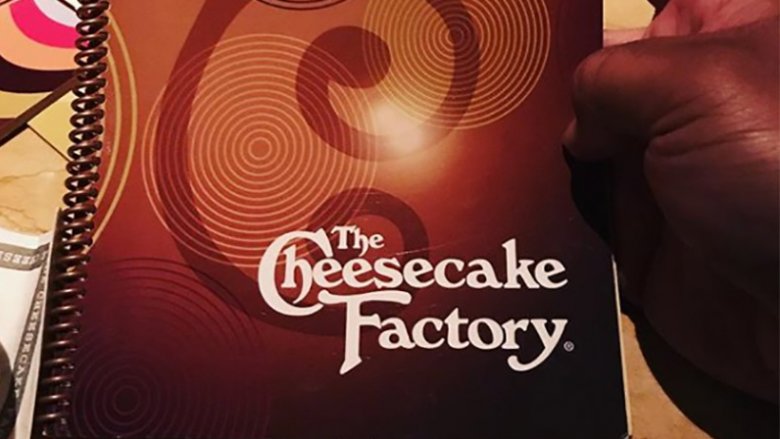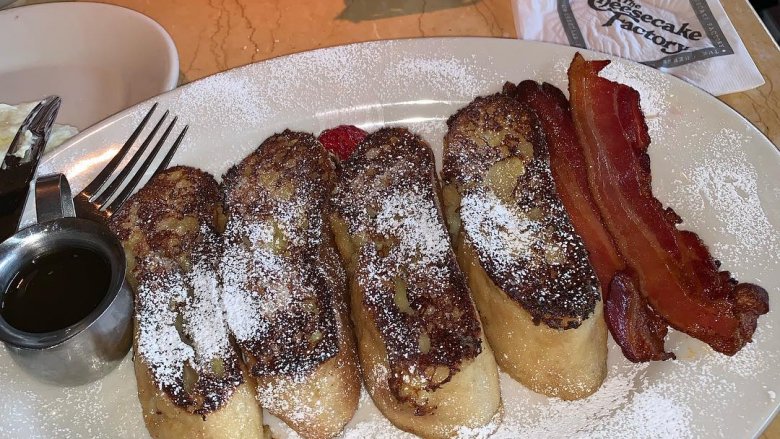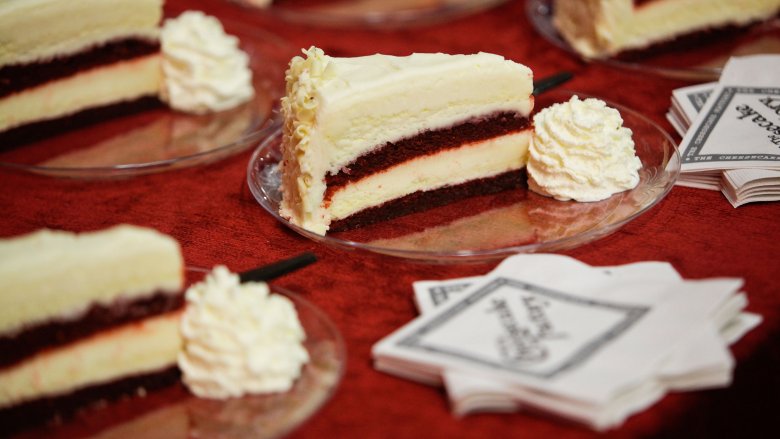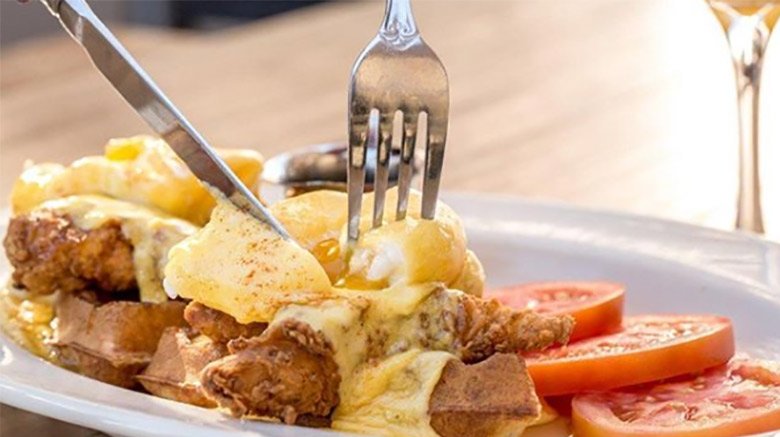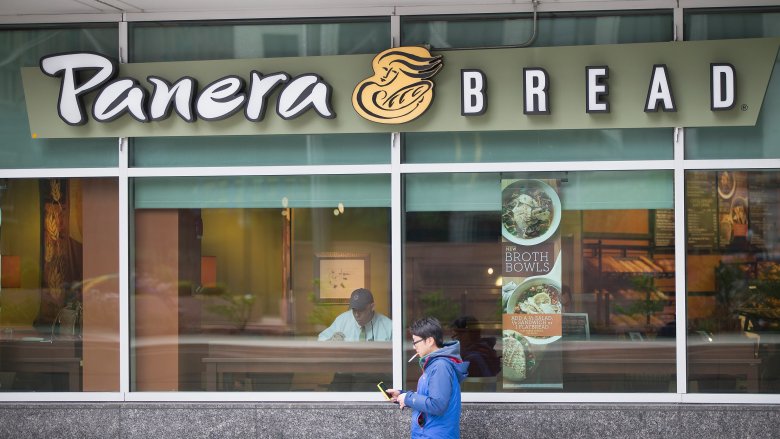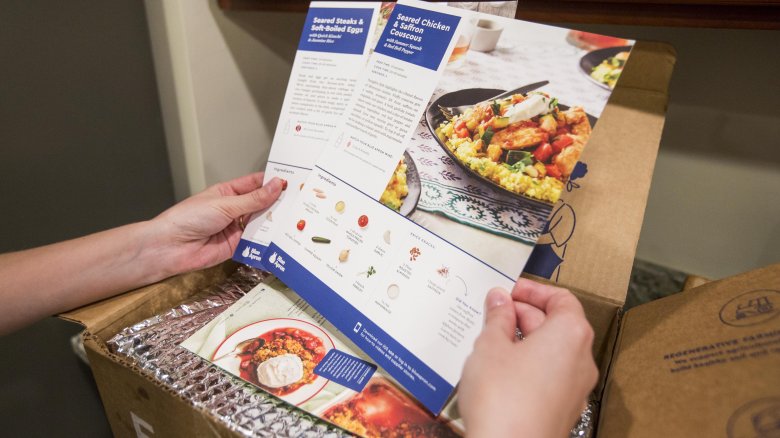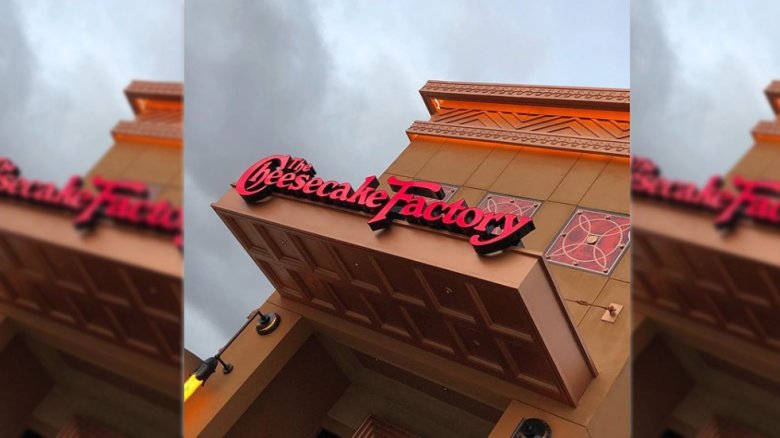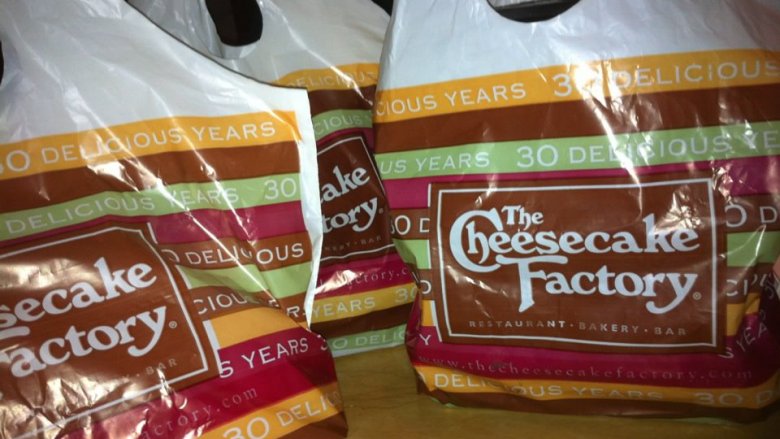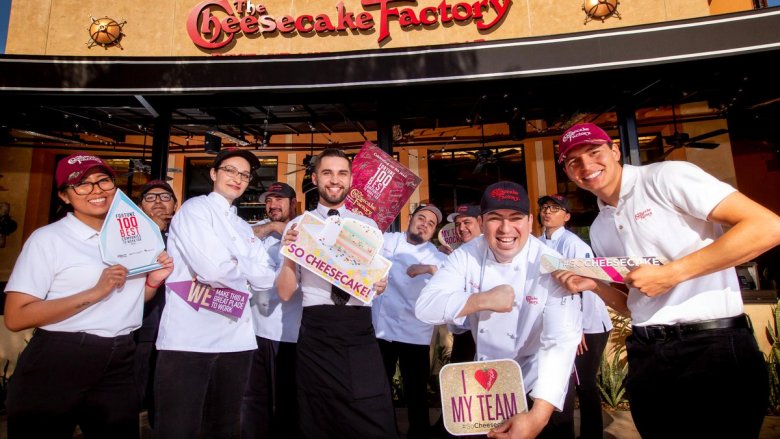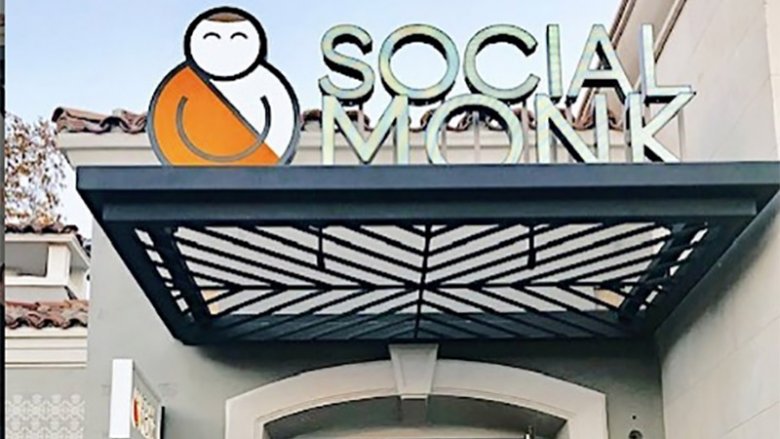The Real Reason Why The Cheesecake Factory Is Struggling
When it comes to having your pick of cuisine and over a dozen varieties of cheesecake to choose from, there's no place but the Cheesecake Factory. The restaurant with its over the top decor, vast array of cheesecakes, and equally bloated menu has grown from its California roots to spread throughout the United States and as far across the globe as Hong Kong and Dubai.
As of 2018, there were 198 Cheesecake Factory restaurants throughout North America, but the public's taste for this sweet casual dining chain seems to have soured lately. The company has been closing long-standing locations and is feeling the pinch of a change in the U.S. restaurant industry that has impacted so many other restaurant chains. Their restaurant numbers are holding steady, but sales in recent years have been stagnant. So why is this popular mall dining staple struggling, and what might its future look like?
Their menu is way too long
Next to its array of decadent cheesecakes, the restaurant is probably best-known for its incredibly long menu. The sheer size of it can be as overwhelming as it is appetizing. So why have a menu that contains 250 items? Well, basically because when its founder started it more than 40 years ago he had no idea what he was doing.
"I wasn't a chef, I had no experience in the restaurant business...," said founder David Marshall Overton. "I made sure that everything we served, was something I could make myself." And he kept adding to the menu as he learned how to make new things.
Overton admitted that he got carried away and probably could have streamlined its offerings a bit more. "I probably should have kept the menu slimmer, if I knew then what I know today... I had no idea we would become a chain, and would have to recreate this menu dozens of times."
The trend of the long menu appears to be waning with American diners. According to The Washington Post, national chains have begun slimming down menus over the last decade, both to cut costs and because the food culture has become more focused.
Essentially, "the larger the menu, the more consumers might worry all those things aren't going to be all that good," Maeve Webster, a senior director at food industry research group Datassential Menu Trends, said.
Maybe the Cheesecake Factory didn't get the memo.
It's not exactly a cheap meal out
The Cheesecake Factory certainly qualifies as a decadent night out with its page-after-page menu and dessert selection, but that decadence isn't cheap. Entrees run from around $15 to $21 and while that's not on level with say a Morton's Steakhouse, those aren't Chili's prices either.
Unfortunately, the prices at the Cheesecake Factory have continued to climb over the years. From 2011 to 2015, the average check total grew by nine percent. In 2017, the average check jumped to $21.85 compared with $19.70 in 2013. A lot of these increases likely have to do with those rising labor and insurance costs.
"With the minimum-wage increases you need to increase menu prices accordingly," Janet Lowder, of the consulting firm Restaurant Management Services in Rancho Palos Verdes told The L.A. Times. "It needs to be done strategically — every couple of months you add a quarter to this item, 50 cents to that one — so it doesn't look like a huge increase across the board."
As the already high costs continue to increase, the number of diners who are willing to shell out for a night at The Cheesecake Factory is likely going down.
The company has faced some legal troubles
Lawsuits involving chain restaurants are nothing new, but they're never good for business. In recent years, The Cheesecake Factory has had its share of legal troubles that resulted in both big and small payouts.
In 2013, the restaurant settled a lawsuit for $14,000 with a Wisconsin man who brought a suit against them, claiming that he ate a bad piece of fish at the restaurant and became ill. The patron began profusely sweating and passed out in his chair before falling onto the dining room floor, just minutes after finishing his meal. Paramedics were called, and it turned out he was suffering from a type of food poisoning that happens when fish is stored incorrectly and begins to rot.
Then in 2018, the restaurant group found itself under investigation by the U.S. Equal Employment Opportunity Commission. The case involved a newly-hired deaf Seattle dishwasher who alleged he was fired because of his disability. That ended with the Cheesecake Factory shelling out $15,000.
Both of those legal cases though were small potatoes compared to the bill that the restaurant had to pay in 2018 regarding a lawsuit that claimed its janitors were being underpaid. The California Labor Commissioner's Office found that the restaurant owed 559 janitorial workers stolen wages to the tune of $4.57 million.
Not only did these cases bring plenty of bad publicity, but hefty fines that definitely weighed down their bottom line.
People want healthier food
Restaurant diners today are also demanding that their food be healthier and fresher. A good selection of healthy menu options is important to at least 70 percent of diners, according to the National Restaurant Association. And it's not just millennials driving that change — this one involves Generation X, as well. While The Cheesecake Factory does make all of their food with fresh ingredients, it's hard to market yourself as healthy dining when you're known for large portions and decadent desserts.
And many of its dishes really are unhealthy. The restaurant was named by the Center for Science in the Public Interest as the winner of its "Xtreme Eating" survey in 2014 for having three of the unhealthiest dishes in the country. As mouth-watering as the Bruléed French Toast looks, it's hard to justify ordering a breakfast that's packed with 2,800 calories and 93 grams of saturated fat.
That accolade wasn't enough to scare The Cheesecake Factory into a diet and once again, in 2017 it took home top honors with its 2,310 calorie Pasta Napoletana.
While they did release a SkinnyLicious Menu in an attempt to keep up with the times, even that is a minefield of fat, sugar, and sodium. It's no wonder that health-conscious diners may be finding other places to eat.
Millennials are moving away from old casual-dining trends
Okay, so the headline "millennials are ruining..." has become a tired cliché. Fair enough. That said, the millennial generation has become the largest consumer group and their spending habits are without a doubt influencing the restaurant/food industry. If you own a food truck, this is great news, but if you run a casual-dining chain restaurant, eh, not so much.
With more food options available, casual-dining chains are simply struggling to get millennial customers into their booths. A big reason for this is the internet. According to one survey, 58 percent of them use the web to seek out the best deals before going to a restaurant and 55 percent will only visit if they can find an online coupon. Simply walking blindly into a Cheesecake Factory doesn't happen as frequently.
There's also the issue of adapting to the "gotta have it right now" mindset that millennials have been labeled with. Whether you call them fast casual or quick service restaurants, millennial diners make up 51 percent of the base at these eateries where they can be in and out the door in under a half hour. Good luck squeezing a 30 minute dinner in at Cheesecake Factory — you'll probably be waiting on a table at least that long.
Labor costs are rising
It's not easy being an hourly employee in the food industry, but it's also not easy running a chain of restaurants dependent on hourly employees. When numerous states across the country implemented an increase in minimum wages in January 2018, restaurants scrambled to find a way to adjust to the change and stay afloat. The Cheesecake Factory was hit especially hard according to the company's CFO, Matthew Clark. It's stock plunged 14 percent and it's largely due to California's minimum wage climbing its way towards $15 an hour in 2022. At 38 restaurants, the company has more locations in California than any other state and they're feeling the pressure.
According to Clark, hourly wage rate inflation is hovering around 6 to 7 percent, giving them "the highest Employee Cost Index that they've seen in a decade." Making the adjustments have squeezed the company's finances and pushed restaurant labor costs up to 35.8 percent of the company's revenue as of July 2018, up from 32.1 percent in 2013.
People have more options for cooking at home
Back in the dark ages, if you wanted to cook a meal you had to go to the grocery store and comb through the aisles for every ingredient. That made heading to a restaurant like The Cheesecake Factory an easy choice. Thanks to technology, now even the laziest among us can be home chefs and whip up a healthy meal like grilled salmon with roasted heirloom potatoes without having to set foot in a grocery store (or even look up the recipe). As of June 2018, there were at least 12 major home delivery meal kits available, and industry experts say it's making Americans more savvy with our food dollars. Who can blame us when we can create restaurant-worthy meals for a fraction of the cost... without ever changing out of our pajama pants.
"Millennial consumers are more attracted than their elders to cooking at home," Buffalo Wild Wings' former CEO Sally Smith infamously said in a letter to her shareholders. (That company is facing its own woes similar to The Cheesecake Factory.)
Don't worry, we're not gonna continue to blame millennials, but the meal kit boom is taking a slice of pie away from the restaurant market. Factor in the trend of grocery stores providing pick-up and delivery options and their own meal kits, and people are cooking at home more than they were a decade ago. With more options, people simply aren't hitting up the Cheesecake Factory as often as they once were — especially since those new options take require less effort and less money.
So far, they've escape the mall-pocalypse
Malls may have ruled retail in the 1990s, but that's no longer the case, and after decades of mall growth they've been closing at an alarming rate. One would think that for a chain restaurant so closely associated with the shopping mall that this wave of mall closures would signify doom for the company, but that hasn't been one of their problem areas... yet. The company has managed to avoid the mall extinction that affected chains like the Sharper Image and Sam Goody. So how'd they do it?
In short, the chain has been incredibly picky about which malls to saddle up to and only the coolest, hippest malls make the cut. Fortunately, choosing to go into a busy high-end mall like Nashville's Green Hills Mall over somewhere like the now-defunct NorthTowne Square Mall in Toledo, Ohio has proven to be an effective strategy.
"We've only gone into those A-plus malls that continue to reinvest capital to drive their own guest experience and continue to bring people in," former Cheesecake Factory CFO W. Douglas Benn said in 2017.
Matthew Clark, the company's current CFO, said the company is aware that many malls are struggling and that it "monitors the number of vacancies" in the malls where it operates.
Food delivery is an extra obstacle
It's not so much that millennials don't want to eat at chains, they just don't utilize them in the same ways we're used to. The millennial customer base demands their food be brought to them — preferably via delivery or at least to their car.
According to a 2016 survey, 60 percent of adults who ordered delivery did so to avoid leaving their homes at all, with 41 percent of respondents also saying that they wanted to catch up on their TV shows and movies. (Maybe The Cheesecake factory should add solitary Netflix pods?) "We're seeing a lot more people try out these delivery services, even compared to a year ago," said Caleb Bryant, an analyst for Mintel, the research group behind the study.
This demand for delivery has put more pressure on chains like The Cheesecake Factory to embrace delivery services like DoorDash and Grubhub, but that's not necessarily a good thing for them, either. Not only does delivery kill the chances of making a mid-meal sale like an extra cocktail, a round of appetizers, or dessert, but delivery services charge steep fees that make it difficult for restaurants to make a profit. One New York restaurateur said that, "breaking even" is the best-case scenario.
It's remains a good company to work for
While the Cheesecake Factory may be fighting to keep its head above water and move with the shifting food industry landscape, it's been able to maintain its reputation as a solid place of employment. According to the company's website, it employs more than 35,000 people and strives to "foster complete engagement" with its employees and create an "amazing place to work." Of course, just about every corporation is going to use positive buzz phrases like that on its website. So is there any truth to back up those claims? For the most part, yes.
Fortune put it at #27 on their list of the 100 Best Companies to work for in 2018, citing its commitment to promoting from within. "More than 40 percent of management positions were filled internally in the past year, and senior restaurant manager roles went to current employees 100 percent of the time." In 2019, the company moved up to #25 on that same list.
Of course, no place is perfect, and employees did say that it can be incredibly stressful and the many rules (and massive menu) can be hard to remember. On the plus side, all that cheesecake will only cost you half the price customers pay.
They're expanding into new brands
Even if the Cheesecake Factory has healthy food trends, rising wages, and millennial diners to compete with, it's not giving up so easily. The company is aiming to grow in the future not so much by changing The Cheesecake Factory, but by evolving into other brands. Similar to how P.F. Chang's branched off into the fast-casual chain Pei Wei, The Cheesecake Factory is doing the same, only with restaurants that have nothing to do with cheesecake.
One of those brands is Social Monk, "a pan-Asian concept" that opened in California in late 2018. The others are an investment in the brands North Italia and Flower Child. The first is Italian fare, and Flower Child serves salads, wraps, and other health-inspired menu items.
Cheesecake's CEO said the investment in the new concepts are "doing well" and they're utilizing "Cheesecake's expertise in supply chain, information technology and operations."
Considering the perils outlined earlier, perhaps the company's decision not to put all its eggs cheesecake in one basket might prove to be a smart move.
Supplying medical coverage for workers has been tricky
Grappling with the rising cost of medical coverage for its workers has been a bit of a tightrope walk for the Cheesecake Factory, too. At the heart of the matter is how the Affordable Care Act, aka ObamaCare, impacts the restaurant industry and always changing hours of food service employees.
National Retail Federation (NRF) vice president Neil Trautwein believes that what makes it particularly tricky is the 30-hour-per-week cutoff that separates part-time from full-time employees. It doesn't lend itself well to restaurant workers, argued Trautwein. "Many retail and restaurant employees do not fit neatly into full- and part-time categories," he said. Scott DeFife, executive vice president of government affairs for the National Restaurant Association, seemed to agree with this sentiment. "The restaurant industry is not a nine-to-five, five-days-a-week industry.
That was in 2014 though, and companies were given a relief period of a year to comply and figure out how to make it work. It seems that four years later, however, The Cheesecake Factory was still struggling to navigate health insurance costs. According to Clark, $4.6 million in higher group medical insurance costs year-over-year led to smaller than expected revenue in August of 2018.

